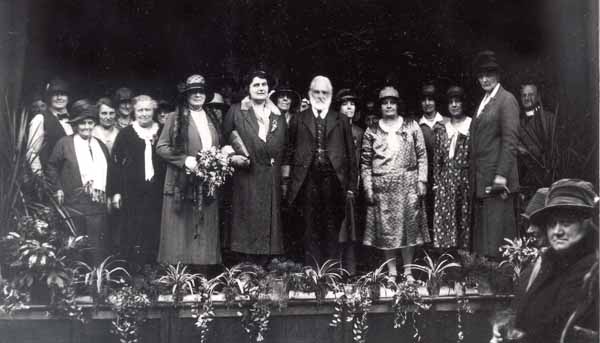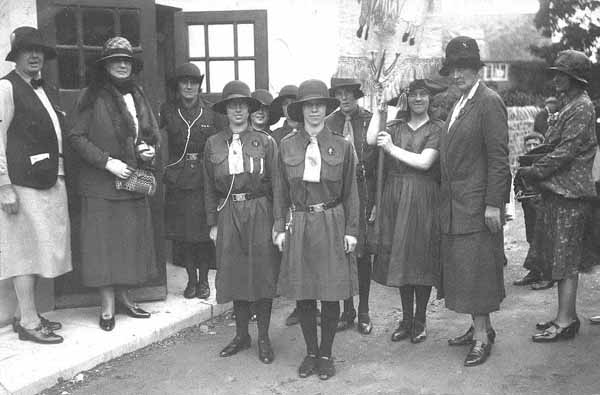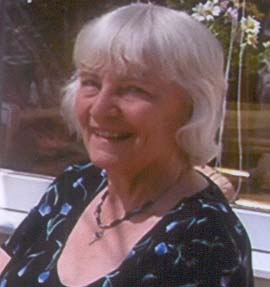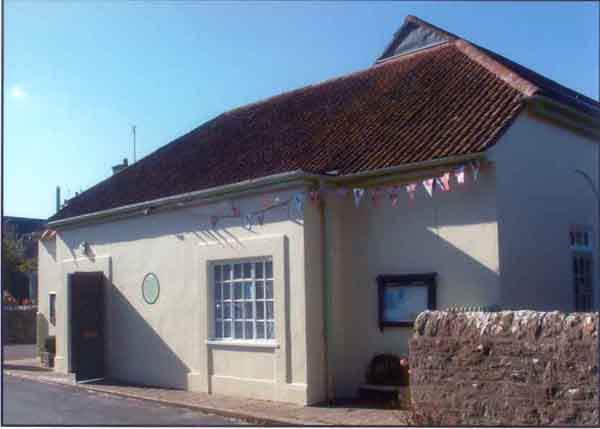Researched and written by Wendy Green - 9th September, 2004

A Brief History of Burton Bradstock W.I. Hall
The following details were put together by Mrs. Wendy Green in the summer of 2004, which she compiled after reading the Archives of Burton Bradstock W.I. It is therefore limited by the written records available to her.
73 years ago - in May 1931 - the W.I. Hall was officially opened. To celebrate the event over the weekend there was a Fancy Fair, a Dance, a Concert and a Whist Drive - jointly making a profit of £90, 4 shillings and 10 pence. The story of the hall, however, begins several years before this date.

W.I. Hall opening - May 1931 (click here for names in picture)
As you may know, the B.B.W.I. was formed in November 1917. Their first meeting place was the village school, which was used intermittently with members' houses, notably "Gages" and "The White House". The school proved unsatisfactory in many ways, e.g. small chairs, paying rent, etc. and it was no good for entertainment or lectures and was "unhygienic" (for whom?) and a fire hazard. With a membership of over 40, there was a need and a longing for a permanent home of their own. It so happened that one W.I member, Alice Fielding, was a cousin of Captain Pitt-Rivers, who owned most of the village and its surrounding land. In discussion with Captain Pitt-Rivers they agreed that the village was badly in need of a hall for social, recreational and educational purposes. Pitt-Rivers said he would provide the land if they could organise building the hall. They could use his architect, Jupp, and his land agent, Sanctuary, would liaise with them. From here on things moved quickly.
(1) First a site was chosen - there was a choice between a plot where 2 cottages had burnt down in Shadrack or part of a plot used by Mr Smith to grow his potatoes. The latter was chosen, and a plot of about one sixteenth of an acre was allocated at a cost of £40 freehold = £640/acre.
(2) The next most important action was to raise funds, not just for the building but also for the furnishings.
(3) Plans were drawn up by the architect and the costs worked out - these were initially £1,765.
(4) Work began on the building in October 1930 and, with just a minor amendment of raising the roof 3 feet to accommodate badminton in the hall, building went ahead.
(5) Work was completed by May 1931 - a mere 7 months. Already, however, clouds were appearing on the horizon.....
A major one was Mr. Smith, known as "The Duke" who, with his wife, terrorised the villagers. He unfortunately rented the potato patch, on part of which the hall was built. He was not a happy man! There were two main areas of contention, apart from the fact that there was a hall at all. First the siting of the septic tank and secondly the use of the road on the west side of the hall. The tank was unfortunately put in the wrong place by the builders, but as it was to be used by other houses around the hall, it was left where it was. The other grouse - the road - is proving a problem to this day. It was considered necessary only for foot access to the west side of the hall, but Smith wanted a fence erected, to secure his potato patch. This demand was only included after the contract had been signed and costs agreed. The W.I. was adamant that they could not agree to this extra cost and also a fence would be a hazard in case of fire. They refuted Smith's allegations that children and animals were getting on to his land and ruining his crops - this in spite of the fact that he kept the gate firmly locked. (Road access on the west side is still giving the W.I. trouble today - though the natives are friendlier!!) In the end Pitt-Rivers paid for the fence. So the W.I. settled happily into their brand new hall, which was furnished by appeals for donation of chairs, tables, kettles, curtains, cutlery, etc. and even a piano was purchased on the "never-never". Even in those days they needed to get Public Liability insurance, workers compensation and fire policies. With a final cost for the building now reaching £1,822, 8 shillings and 6 pence realised by a bank loan, finances became a major concern. Unfortunately, many of the promises and pledges of financial help before the hall was built did not materialise because of the stock market crash and resulting financial depression in the early thirties.
Renting out the hall to various organisations both within and without the village became a necessity, as it is to this day. Ironically perhaps, the school took full advantage of the new hall for Domestic Science classes and concerts, though there was a complaint that children were running amok in the hall and caused some damage. There were also complaints about the schedule of charges for the hall - they were not clear (nothing changes!) War clouds were now gathering, and these were reflected in a note to the Parish Council offering the hall as a dressing station in case of air raids. But this was superseded in the autumn of 1939 when the hall was used as a temporary school for evacuated London children. The W.I. continued to use the hall for its meetings until 26th June 1940 when the hall was requisitioned by the army at £60 per annum. The hall had to be cleared by that night - the piano was removed to the church and the caretaker was suspended. When the hall was not used as a billet, it could be used for dances, as a canteen and for social occasions. So the W.I. were back to using "The White House" and "Gages" for committee meetings and the "Rookery" for W.I. meetings. Numbers dropped alarmingly, however, because meetings were held at 2.30pm because of the blackout, but for many members who were engaged in war work, with long hours, home ties and no help, it was impossible to attend.
There was some concern in the hall about the soldiers' use of chairs. It was decided to remove them before the next regiment arrived. However, Major Barrett requested the use of chairs for entertainment and he also wanted the loft cleared. It wasn't until the end of 1942 that this was undertaken and it was noted that 2 benches and 12 chairs were missing. Were they used in the stove to heat the hall?!! There was also a fire in the shed at the side of the hall. This was covered by insurance, but there was no wood available to rebuild the shed. In August 1945, the hall was de-commissioned by the Southern Command, however it was not in a fit state to be used. Repairs were necessary for the secretary's table, kitchen table, oil stove pipes and piano. Repairs were begun when the War Department agreed damages and issued a licence. It was not until April 1945 that the W.I. hall was in use again.
Almost immediately the organiser for school canteens requested the use of the W.I. Hall kitchen for preparation of dinners for Bride Valley schools - all equipment necessary would be provided by the Authorities and the hall would be used from 9.00 am to 2.00 pm. This was agreed. Another quite different request came in May 1945 (before the hall was decommissioned) from the Royal British Legion (Chairman Mr Howarth) to buy the hall to create a centre for the social and community life of the village, offering a large hall, reading room, games room, canteen, etc. used by all the villagers and a social club for the young people. I believe there were post-war grants available, but the W.I. could not sell to another organization, but only to a properly constituted village community council.
The late 1940s and 1950s were the heyday of the hall. There were dances almost every week with whist drives, Bingo, social events, concerts and meetings. Even the Food Office used the hall for the distribution of ration books, making the hall the focus of most social occasions in the village. By 1953 all loans were paid off and in 1957 the hall was connected to the main sewerage system. At the beginning of the War, Miss Fielding died and it was not until l949 a clock was bought and engraved with a brass plate in memory of Alice Fielding and Miss Codrington. Where is it now? Stolen in 1989.
This period was not without problems, however -
(1) The caretaker had to be paid more.
(2) The drains were blocked by grease from the school meals.
(3) There was trouble after some dances, particularly motorbike noise - the police were asked to patrol outside.
(4) The hall was damaged by the youth club - walls and windows in particular. They were suspended for a year.
(5) The lock on the kitchen door was tampered with.
(6) 2 chairs were missing - reported to the police - but they were returned 18 months later in an R.D. council van.
Towards the end of the 1950s, the hall was showing wear and tear on account of the increased usage. The hall floor was damaged beyond repair - a new one was needed, which had to be wooden as it was a dance floor. The hall also needed redecoration inside. Then in the early 1960s after floods, the stove was beyond repair. If this wasn't enough gloom and doom, the Educational Department terminated its lease with a loss of £80 per annum and the hall lets disappeared, possibly due to TV and cars. If the 1940s and 1950s were the heyday of the hall, the 1960s proved to be the nadir. Money was tight. Mrs. Wratislaw loaned £300 interest free. Sales of allsorts were held and some ingenious money-making schemes were thought out e.g. Elizabeth's farthings: threepenny pieces in Smartie tubes, etc. Newspaper collections (by the Cubs) ended in 1991 because of the trouble they caused with the road and access, neighbours, etc. But the most outstanding money spinner was Bingo - this in spite of the fact that some members did not approve and tried to introduce Scrabble - unsuccessfully. And so began a remorseless round of hall repairs and refurbishment, with fund raising to pay for them.
In 1967 - the W.I.s 50th birthday - it was stated that "We raise about £200 a year for maintaining the hall as a community centre for the village!"
In December 1970, the President's address drew attention to the amount of effort and cost entailed in the maintenance of the hall - an increasingly heavy burden on the W.I. Appeals to village organisations came to very little in the way of help. Grants from the Rural Development Fund 25% cost and Parish Council £450 in 1994 towards the cost of kitchen renovations, brought severe censure from the West Dorset auditor, for the Parish Council funds should not have been given to a private organisation! We were successful, however, in getting £5,000 from the Lottery to replace the central heating system.
We have a hall of which we are justifiably proud. This has been achieved through the dedication and sheer hard work of B.B.W.I. members over the past 75 years. Although one can but admire their sacrifice and dedication, one can also, in retrospect, question the wisdom of their actions. Would it not have been better from the start for the village to have built and owned the hall?

Wendy Green, 9th September, 2004
President Burton Bradstock W.I. 1998 to 2001
Post script
The WI subsequently leased the Hall to a newly formed Village Hall Trust on 1st January, 2005, so it is now Burton Bradstock's Village Hall as Wendy suggested.

The Village Hall in 2005
Back to W.I.Index |